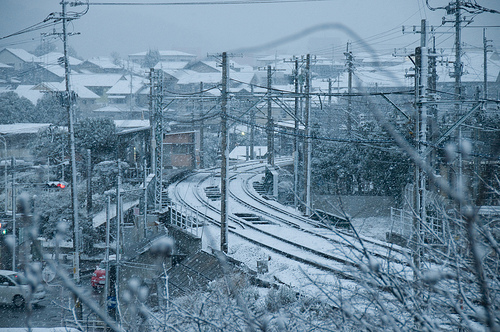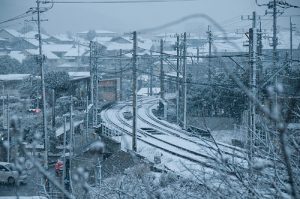The Eurostar case: learn the lessons, for this is not a good case of social media use

 We Are Social, the firm behind Eurostar’s presence on Twitter and Facebook, have written a note about their role in helping the rail company respond to the ongoing travel difficulties starting on 18th December, and continuing as I write. Eurostar ignoring Twitter, and especially @colettebalou who was stuck on one of the broken down trains, was first covered by TechCrunch.
We Are Social, the firm behind Eurostar’s presence on Twitter and Facebook, have written a note about their role in helping the rail company respond to the ongoing travel difficulties starting on 18th December, and continuing as I write. Eurostar ignoring Twitter, and especially @colettebalou who was stuck on one of the broken down trains, was first covered by TechCrunch.
Let’s set one thing straight: social media is important in all of this, and Eurostar has not done it well.
I was not on one of the trains that broke down, but I was at Brussels Gare du Midi on Saturday morning waiting for almost 5 hours for a non-existent Eurostar. The only information available to passengers there was an announcement every half an hour or so telling us that they knew no more. The Eurostar website at that time just announced no service until further notice. I had a laptop with wireless internet and hence – mostly via Twitter – could find out more than any other passengers. There was a 32 minute period between passengers being informed at St Pancras that there were no trains, and the same happening in Brussels. When the company let passengers down with its regular communications, Twitter was the tool to network complete strangers in 3 cities together. I’m immensely grateful (in no particular order) to @janephill @laylamoran @lemercier @mreys @Tassia09 @Arnout @Chaos_Theory_Be @cjtrigg. For the passengers on the stranded trains Twitter was the main means for them to state to the outside world what was going on, and the mainstream media cottoned on to this.
All of the main communications between us passengers on Saturday morning were already well developed before any tweets from @creamoflondon (the Belgian Eurostar Twitter account) and @little_break (the UK Twitter account, run by We Are Social). The first tweets were a full 14 hours after the problems started to develop on Friday evening. However you look at it this is not good enough. Some people have naively stated that Eurostar would have been better fixing the trains that tweeting. Oh, come on, how many PR people are qualified to fix a 300km/h capable 700 tonne train?
The question has then been raised as to who should actually have stepped into the debate about the Eurostar mess on Twitter. We Are Social’s note is essentially a denial of responsibility, although at least an honest one – Eurostar, prior to the mess, were only dipping their toe in the water to test social media gradually. It’s also beyond me what these regular meetings between them and Eurostar could actually have entailed – their account has just 782 followers, quite some way from a stellar social media performance for a company whose trains carry 8 million people a year! That has not stopped some commenters from praising We Are Social for their approach. Today, the 3rd day of the mess, @little_break has written 4 tweets – again that is not active enough. Yes, We Are Social are fair and honest, and Eurostar could have used them better. But they too could have done better. Plus all of this follows from yesterday’s inconsistency between the social media messages and the messages in the stations.
Also how many of these people thinking they are capable of commenting have actually got any first hand experience of any of this, at least when it comes to the inconsistencies? Very, very few of them. I’ve been at the stations, have seen what’s happening there, used Twitter from the station and to follow the story subsequently. In amongst all of this there has at least been some sense – that social media should not be the main channel of communication (but the others haven’t been working either!) and that all PR and comms should be joined up.
Overall the responsibility lies with Eurostar, and Eurostar has handled all of this badly. But this should be a case study for how to use social media better in the future, for the story does not show any of Eurostar’s communications channels in a positive light.
@Rich – there is the safety tunnel between the 2 rail tunnels. See the diagramme here. There are special vehicles that run in the safety tunnel, they can operate in both directions and are slightly narrower than regular buses. You can see them stabled to the left side of the train when a London-Paris Eurostar leaves the tunnel, on the French side.
Great post Jon. I heard from a fireman friend a few days ago that all tunnels have separate tunnels for fire crews to get down. Could they not get a coach down there instead of leaving people stranded?
Fair point about the time to get people to one door…
As for dragging out the stranded trains – they have 5 locos to do that (more here). Problem is that these can do 100km/h only and are diesel, and you need at least 2 of them to drag a Eurostar. They should have more – and stronger – machines on standby and make it first priority to drag broken down trains out of the tunnel. Should be easily possible to guarantee maximum 1 hour in there.
I don’t understand why it isn’t already first priority to get any broken down train out as fast as possible. OK these were the last Eurostar services of the day, but Eurotunnel had a large number of their own customers trying to get on the Shuttle (which runs round the clock), so the blockage had a direct effect on their own business, regardless of what contractual arrangements exist between Eurostar and Eurotunnel to deal with disruption. I imagine we’re going to be treated to the unedifying spectacle of the two companies blaming each other for the mess.
If the locos aren’t powerful enough, they should have got better ones. A laden Shuttle can’t be any lighter than a Eurostar, so do they need two locos for any break-down?
As for their speed, all that was needed was to get them to the Shuttle terminal at Cheriton or to Ashford. From there, they could either get pasengers into other trains, cross-platform, or bring in more powerful (electric) locos to haul the trains up to St Pancras. At the very least, passengers wouldn’t have to suffer from the heat/humidity and claustrophobia inside the tunnel for too long, and it would be easier to supply them with food/water if necessary.
Hi Jon, I think you underestimate the effort involved in evacuating the train. Lining up the doors is the least of the problems. You know yourself how long the train is. Getting a full load of passengers (and luggfage) down the train to the right door(s), especially in dark/stuffy conditions with many likely to be panicky, not to mention young children and those less mobile, would not be easy. That Eurostar/Eurotunnel apparently got very few staff in place to assist with the trains which were evacuated would have made the task even harder.
I don’t understand why they couldn’t haul the trains out, as they eventually did with two or three of them. There should be locomotives on standby at both ends of the tunnel speciifcally to clear blockages. Getting the trains out, either to the shuttle terminal or to Ashford, would have minimised the problems, even if the length of the overall delay wasn’t significantly reduced.
On a Friday evening, whoever was left as duty manager evidently didn’t have the clout or the nous to deal with the problems, and didn’t call in their bosses until much later. You’ll probably find that Eurostar’s breakdown fee to Eurotunnel is much less than the tow-out fee, so that the initial instinct was to wait for a while and see if the trains “thawed out” and could then restart.
On the mainstream media front, throughout Saturday, the focus was on the individual horror stories of a self-selecting sample of passengers. BBC, Sky etc appeared to make little effort to push Eurostar to give useful/accurate information for intending travellers. At best it was an afterthought, and of no use to passengers such as yourself booked on trains on Saturday or Sunday.
It’s very easy to evacuate an Eurostar train. The trains are so long there’s always 1 exit door from the train that’s adjacent to a door to the rescue tunnel. See this for how the tunnel structure works.
Why they didn’t move the people off the trains sooner I have no idea.
One question that I haven’t heard being asked is about their accident awareness and reaction. What would have happened if, as has happened before, there was a fire? Would they have left four trains full of people underground for almost a day?
If the answer is yes, then Eurostar fails all Health and Safety requirements. If the answer is no, then it begs the question of why were so many people left so long?